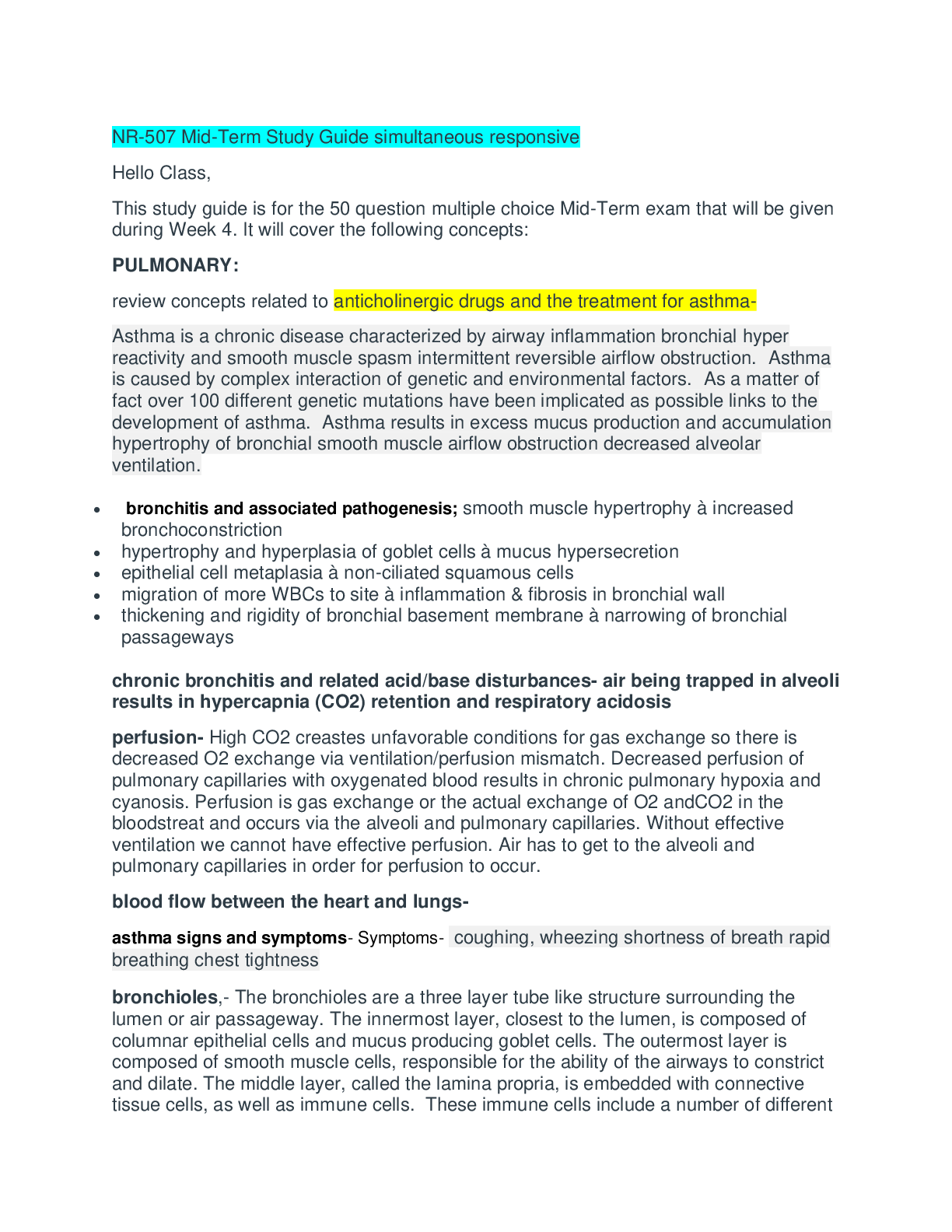*NURSING > STUDY GUIDE > NR 509 Mid-Term Study Guide (All)
NR 509 Mid-Term Study Guide
Document Content and Description Below
NR 509 Mid-Term Study Guide • Articular structures include joint capsule and articular cartilage, the synovium and synovial fluid, intra-articular ligaments and juxta-articular bone o Articular d... isease involves: Swelling Tenderness of the joint Crepitus Instability “locking” Deformity Limits active and passive range of motion due to stiffness or pain • Extra-articular structures include periarticular ligaments, tendons, bursae, muscle, fascia, bone, nerve and overlying skin o Extra-articular disease involves: “point of focal tenderness in regions adjacent to articular structures Limits active range of motion RARELY causes swelling, instability, joint deformity Know the sources of joint pain (pg. 627 algorithm) • Nonarticular conditions: trauma/fracture, fibromyalgia, polymyalgia rheumatica, bursitis, tendinitis • Intra-articular (acute, < 6 weeks): acute arthritis o infectious arthritis o gout o pseudogout o Reiter syndrome • Intra-articular (chronic, > 6 weeks): chronic inflammatory arthritis vs chronic noninflammatory arthritis o Chronic inflammatory arthritis with 1-3 joints involved: Indolent infection Psoriatic arthritis Reiter syndrome Periarticular JA o Chronic inflammatory arthritis with >3 joints involved: Psoriatic arthritis or Reiter syndrome (no symmetry) rheumatoid arthritis if not RA then systemic lupus, scleroderma, polymyositis *Know what causes saddle numbness and urinary retention (pg. 678?) • CES (cauda equina syndrome) most commonly results from a massive herniated disc in the lumbar region. • A single excessive strain or injury may cause a herniated disc. • However, disc material degenerates naturally as a person ages, and the ligaments that hold it in place begin to weaken. As this degeneration progresses, a relatively minor strain or twisting movement can cause a disc to rupture. The following are other potential causes of CES: • Spinal lesions and tumors • Spinal infections or inflammation • Lumbar spinal stenosis • Violent injuries to the lower back (gunshots, falls, auto accidents) • Birth abnormalities • Spinal arteriovenous malformations (AVMs) • Spinal hemorrhages (subarachnoid, subdural, epidural) • Postoperative lumbar spine surgery complications • Spinal anesthesia Know how retinal detachment presents (p.217) • Sudden, painless vision loss that is unilateral Know what the word obtunded means (p. 769) • The obtunded patient opens eyes and looks at you but responds slowly and is somewhat confused. Alertness and interest in the environment are decreased. Know what cranial nerve you’re assessing when checking lateral gaze (p. 237) • Cranial nerve VI: abducens Know what should be listed under adult illnesses in health history (pg. 10) • Medical illnesses: such as diabetes, hypertension, hepatitis, asthma, and HIV. Also hospitalizations, number and gender of sexual partners, and risk-taking sexual practices • Surgical: dates, indications, and types of operations • Obstetric/Gynecologic: obstetric history, menstrual history, methods of contraception, and sexual function • Psychiatric: illness and timeframe, diagnoses, hospitalizations, and treatments Know what conditions do not have red reflexes (p. 239) • Absence of red reflex suggests an opacity of the lens (cataract), or possibly the vitreous (or even an artificial eye). • Less commonly, a detached retina, or in children a retinoblastoma may obscure this reflex. Know the signs of seasonal allergies (p. 27) • itching, watery eyes, sneezing, ear congestion, postnasal drainage Know how optic neuritis presents (p. 217) • Sudden visual loss that is unilateral and can be painful, associated with multiple sclerosis Know how pityriasis rosacea presents (p. 912) • Oval lesions on trunk, in older children often in a Christmas tree pattern, sometimes a Harold patch (a large patch that appears first) Know what is listed under present illness (p. 9) • Complete, clear, and chronologic description of the problems prompting the patient’s visit, including the onset of the problem, the setting in which it developed, it’s manifestation and any treatments to date. • (OLDCART) Onset, Location, Duration, Characteristics, Aggravating factors, Relieving factors, Treatments (past) Know where the acromion process is (be able to identify it on a picture) • Located between the clavicle and the shoulder *Know what to do if you have a + finding on physical exam but otherwise negative work-up (p. 30) Know what can cause falsely high BP’s (p. 127) • If the brachial artery is below the heart level, the blood pressure reading will be higher. If the cuff is too small (narrow) the blood pressure will read high. • If the cuff is too large (wide) the BP will read high on a large arm Know how to check for nystagmus (p. 737) • Nystagmus is seen in cerebellar disease especially with o gait ataxia o dysarthria (increases with retinal fixation o vestibular disorders (decreases with retinal fixation) o internuclear ophthalmoplegia • Identify any nystagmus, an involuntary jerking movement of the eyes with quick and slow components. ..............Continued [Show More]
Last updated: 2 years ago
Preview 1 out of 42 pages
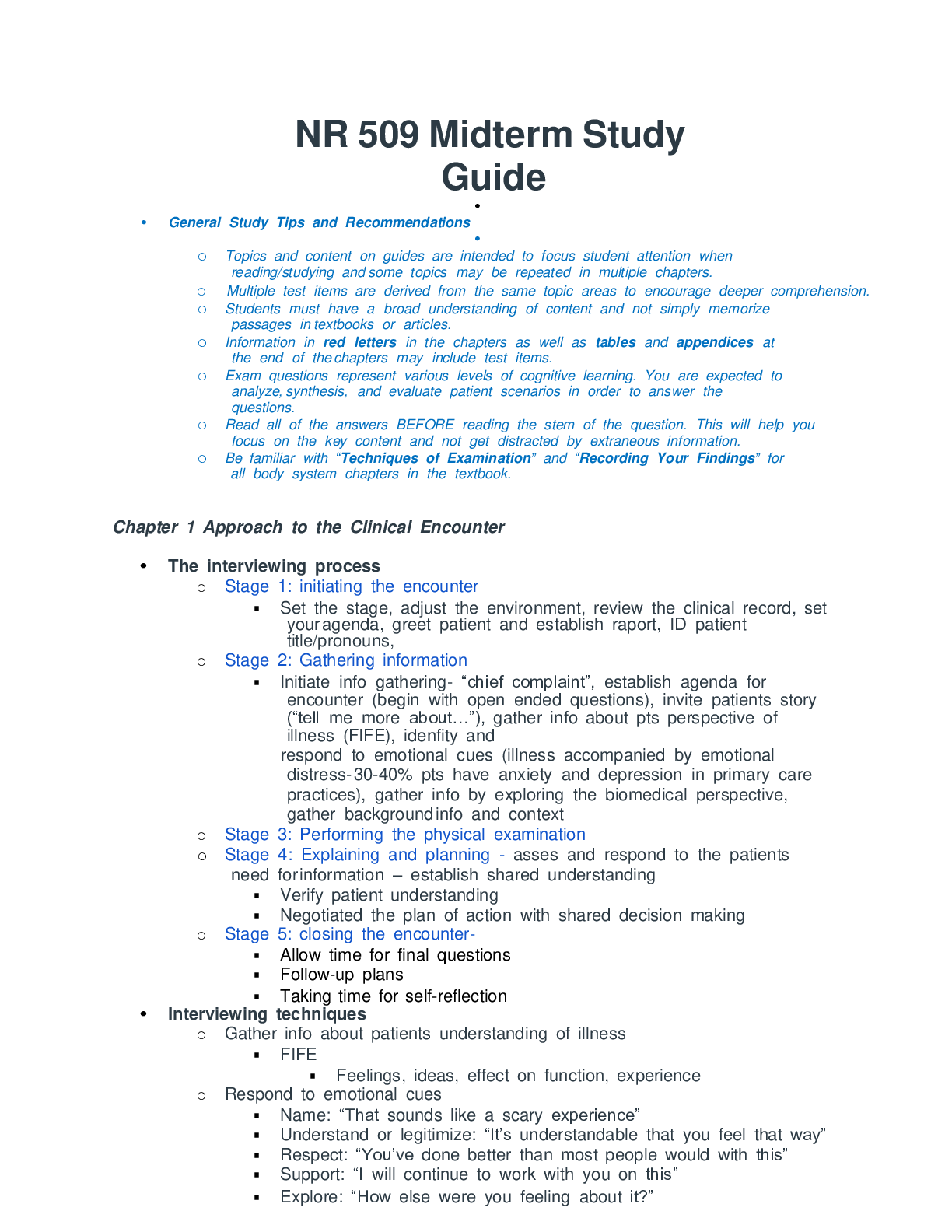
Buy this document to get the full access instantly
Instant Download Access after purchase
Buy NowInstant download
We Accept:

Reviews( 0 )
$23.50
Can't find what you want? Try our AI powered Search
Document information
Connected school, study & course
About the document
Uploaded On
Jan 30, 2021
Number of pages
42
Written in
Additional information
This document has been written for:
Uploaded
Jan 30, 2021
Downloads
0
Views
68













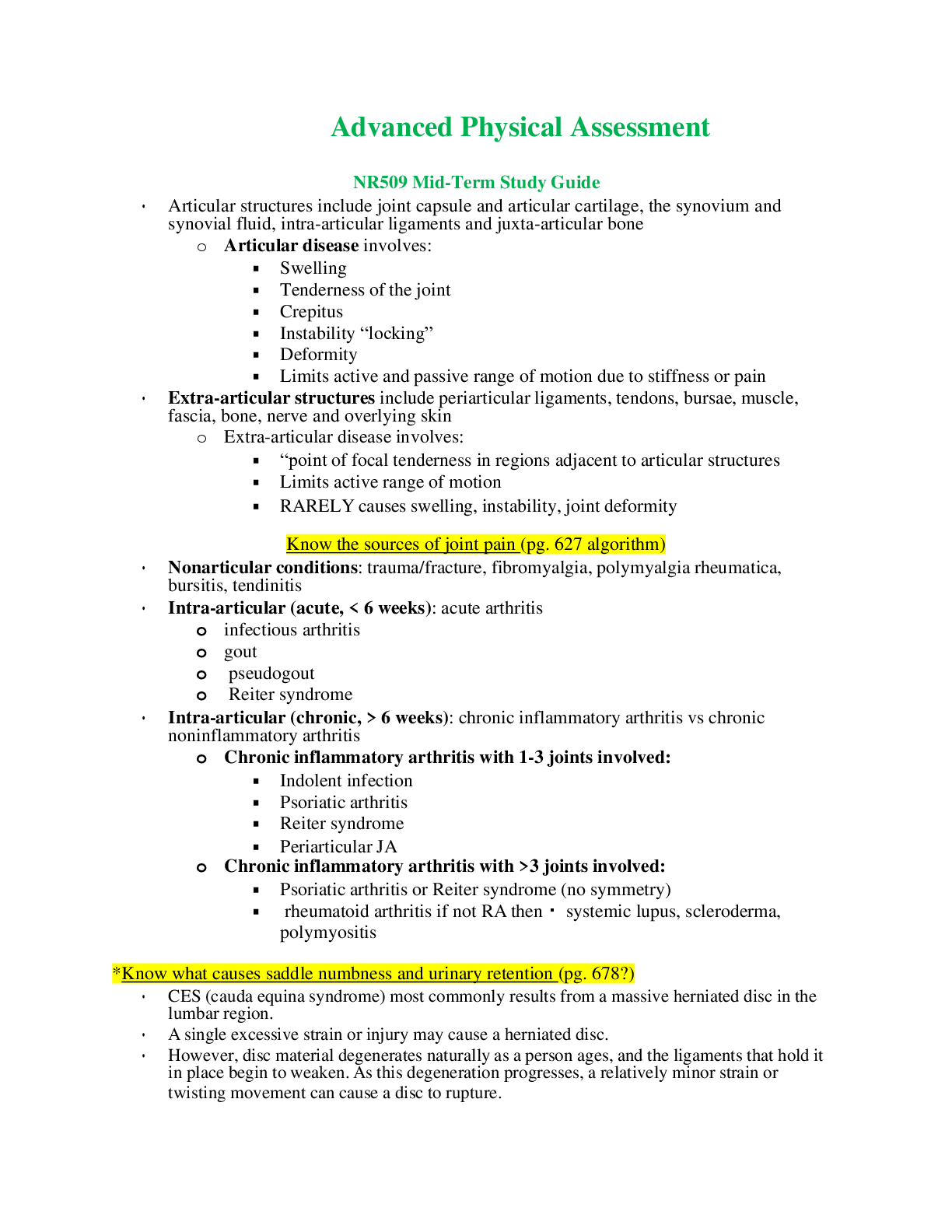
.png)
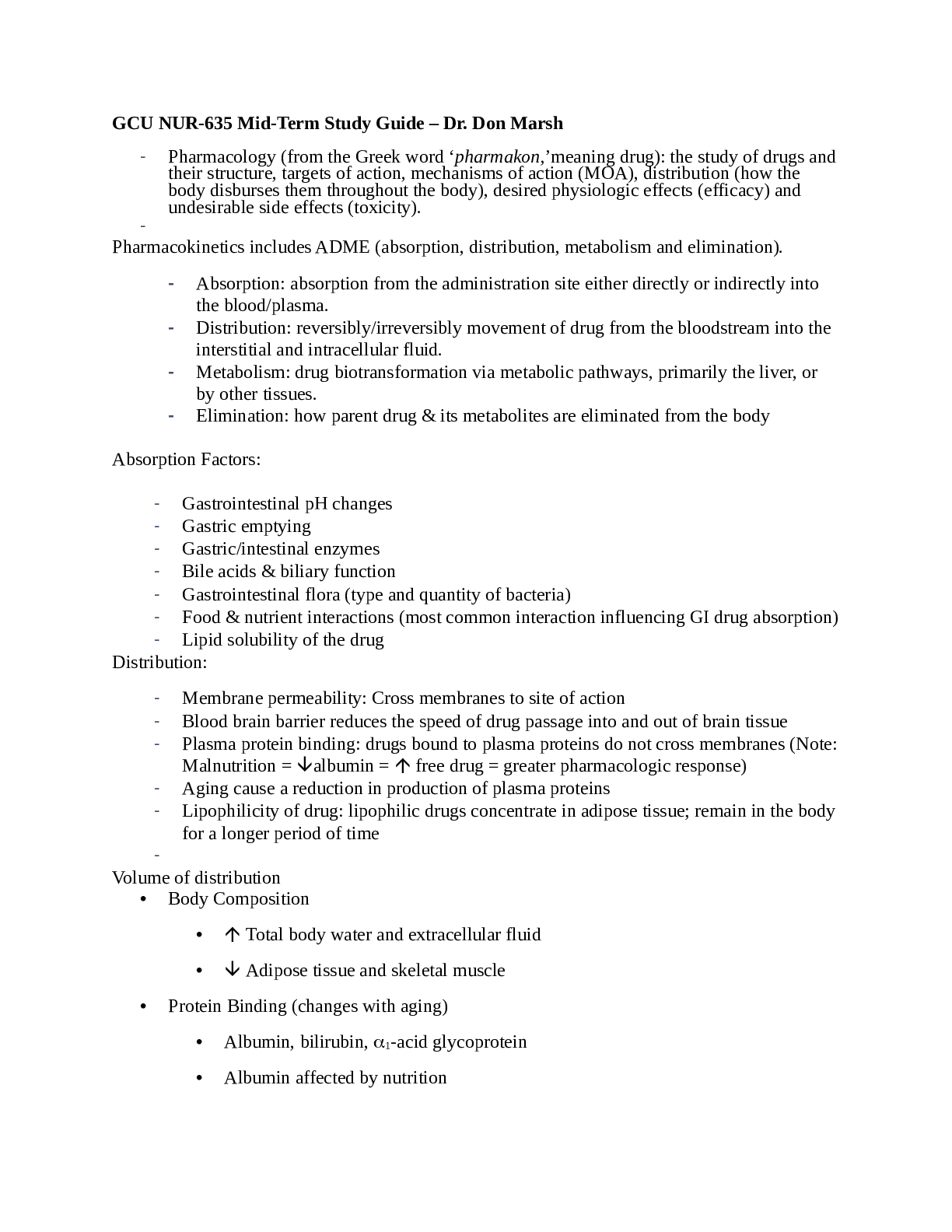

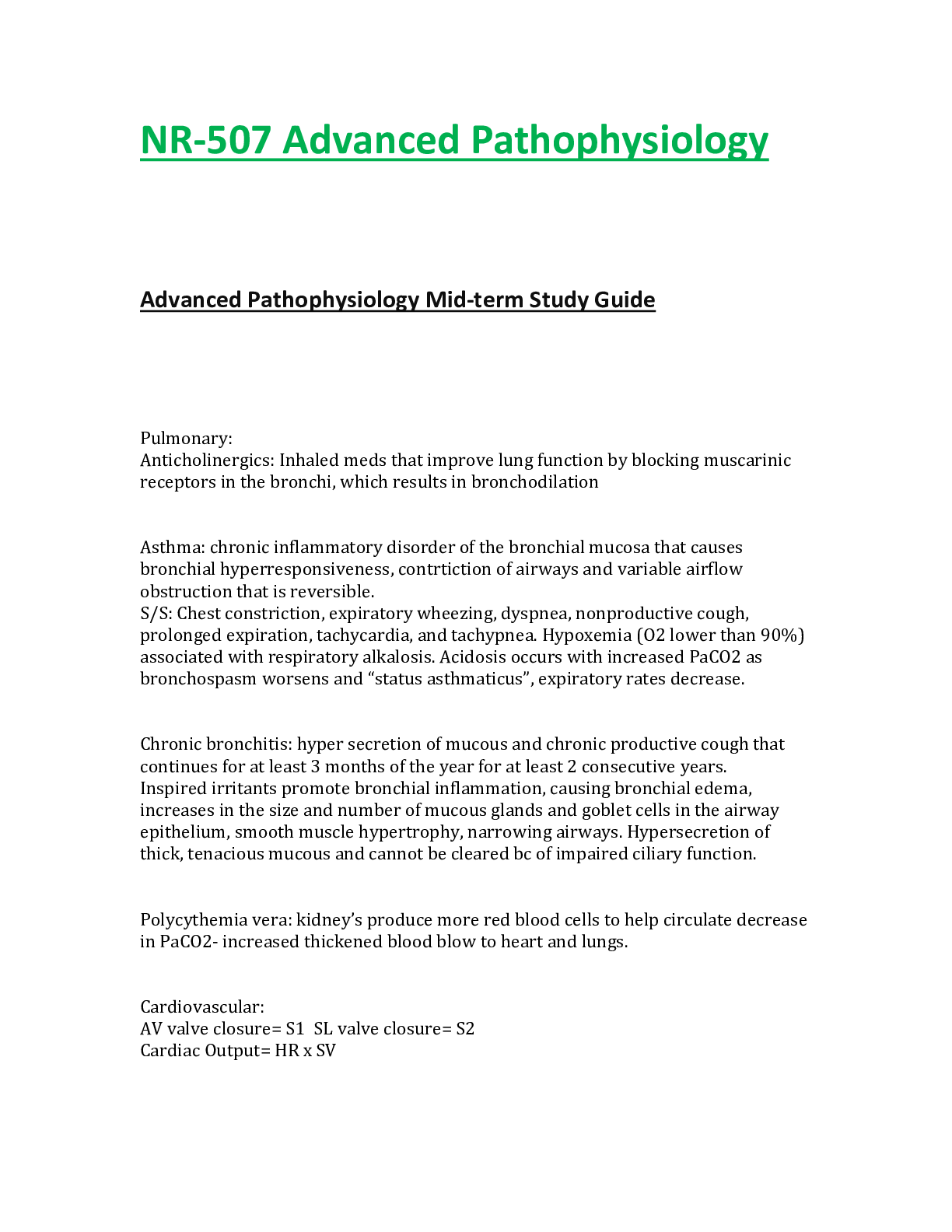

.png)
